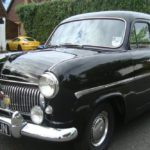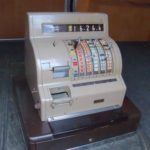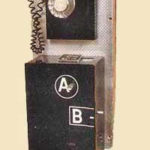Your Local Grocery Store
A visit to your old-style grocery shop was a social activity as well as an essential part of daily living in Ireland before the arrival of the supermarket concept in the 60s. Where else were you to get the local news and gossip if it wasn’t from the person behind the counter or another neighbour you bumped into at the shop? Whatever about the speedy decline of the corner store in cities and towns, rural Ireland managed to hold on to the beloved grocery shop a bit longer into the 70s and 80s.
Before the arrival of the supermarket, your local grocery store sold goods that were almost entirely produced or grown in Ireland. Imagine how limiting this was on the range of products you could buy, never mind the cuisine offered in homes around the country. There was no refrigeration, no convenience foods and very little packaging. In fact, refrigeration was usually a cold storeroom where meats were covered by a fine mesh or net to keep the flies away.
Customers generally produced their list for the shopkeeper and waited for the order to be completed or, alternatively, returned to collect the order later in the day. Some customers could buy their groceries ‘on tick’ and pay at the end of the week or month. The daily order and costs were usually recorded in a small accounting book which was kept by the shopkeeper.
Many items were sold loose and then wrapped in either newspaper or grease-proof paper before being placed in a cardboard box for collection. Who remembers the tins of biscuits, the meat slicer, jars of sweets, canned food, the weighing scales, the shopkeeper’s counter, and the old-style cash register? All now a distant memory.
In the Ballyoughter area, there are two shops that served the local community covering the period from the 1920s through to the 1980s.
Murphy's Grocery Store
Murphy’s Shop was established by Patrick Murphy in the 1920s and was managed on a daily basis by his wife, Margaret Murphy. The shop and animal feed store no longer exist, and a dwelling house owned by the shop owner’s grandson now occupies the same site.
For almost 50 years, the shop provided groceries and animal feed for local inhabitants. Supplies for the shop were delivered by Buttles, Enniscorthy on a weekly basis, usually on Thursday or Friday. Patrick’s son, who worked in O’Connor’s Wholesalers in Gorey, eventually took over the running of the shop and used his employer’s company as the suppliers for his grocery shop. When O’Connor’s closed for business, supplies were delivered weekly by a Mr Hanlon who worked for Herbert Murphy Wholesale. Supplies were also provided by Buttles with delivery by van at the end of each working week.
Meat supplied in the store generally consisted of sausages, rashers, and slabs of bacon. This range catered for the typical demand at the time as many Irish families were reared on the staple diet of Bacon/Rashers/Sausages along with potatoes and cabbage. The meat was stored in a specially designed timber box unit with a door containing fine mesh on its frame for ventilation and to act as a barrier to insects.
Bread was available to buy in the shop but, as a perishable item, it was far more usual for customers to buy flour and wheatmeal to make white and brown bread at home. Some customers were economical and would buy bags of flour as the cotton bags, once emptied, could be stitched together to make bed sheets.
The animal feed was supplied by Davis Mill, Enniscorthy. The feed variety was chicken mash, pig meal and cattle meal. The cattle feed was a brand called ‘Presto’, an American dried corn/maize product which had an appearance like popcorn.
There were two sets of scales in the shop, one light and one heavy, for weighing goods. This was an era when pre-packaging of food was rare and many goods were packaged on site in the shop. The weights for these scales were checked by an Inspector on a random basis for standardisation and to verify that the Lead seal in the base was intact and officially marked.
The shop was busiest on a Saturday at the end of the working week and, of course, after pay day. Customers arrived with their list/order and waited for it to be completed. The shopkeeper would record the order in the accounts book and collect payment from the customer for the previous week’s order.
The shop closed in 1968 with the societal improvements of access to transport and the onset of the more attractive offer of visiting the supermarket in Gorey.
Recollections recorded by the author in conversation with Ger Crean, grandson of Patrick Murphy.
Carter's Shop and Petrol Station
Carter’s Shop and Petrol Station was built in the late 1930s by Peter Carter. Peter, who was born in the neighbouring townland of Ballygullen in 1898, bought a thatched house and a piece of adjacent land in Ballyoughter just before the commencement of World War 2. Having purchased the house and land for the princely sum of £20, Peter spent the remainder of his savings building a general providers/grocery store.
When it came to stocking goods in the shop, Peter sought credit from local suppliers in Enniscorthy and Wexford. A credit arrangement was reached with Stafford’s Providers in Wexford town much to the relief of Peter who had found it difficult to secure credit for his venture. The initial credit agreement was for £5. In later years, stock was also purchased from Armstrong’s in Enniscorthy. This company closed its business in the 1970s and merchandise for the grocery store was then secured from a new supplier in Enniscorthy, Garvey’s Cash and Carry.
Entry to the shop was through the single door at the front of the building which is located second from the left in the photograph below. Behind this entrance door on the left there was a unit made of glass and timber which stretched from floor to ceiling displaying some of the more expensive goods. Stretching from this unit on the left along the full length of the shop floor, there was a high counter separating the goods and shopkeeper from the customers. Access for the shopkeeper to the area behind the counter was via a countertop flap on hinges. On the shelves behind the counter, you could view the array of goods on offer. Purchased goods were carefully wrapped in brown paper and neatly tied with string on the counter in front of you.
To the right of the entrance door there was a small separate storage room for non-consumable items, and which also contained a public telephone. This was the only available phone in area for many years and part of the personal service provided by Peter was to ensure that neighbours were quickly informed of calls from relatives across the country and abroad.
A big luxury for shoppers in the 70s was the addition of an ice cream fridge which was located near the countertop flap. If you were a child of the seventies, you could not forget ordering a ‘penny wafer’ ice cream from Peter and willing him to cut a bigger slice. The real expert knew when to order the smallest value wafer which would ‘finish’ the block, forcing Peter to give a larger than usual slice.
Beside the ice cream fridge, there was a door in the rear wall leading to the ‘cold room’ where meat was stored in a concrete vat covered in fine meshing to keep insects and other creatures out. This area is also where Mrs Carter used the Churn on a weekly basis to make local “farmers’ butter”. The cream for the butter would be supplied from the Carter farm at Ballyeden. Wooden paddles were used to shape the product into rectangular slabs which were then wrapped in grease-proof paper.
Quite often the shop was unattended when you arrived and you either waited patiently at the counter or passed through the cold room to knock on the side door of the family residence seeking assistance. On occasion, you had to wait for Peter to finish his work in one of the sheds nearby before being served.
There was a grain and fuel store adjacent to the shop which was part of the business. This store held up to 12 tons of pig meal and cattle meal. The animal feed brands sold by the shop were Pollard and Bran. A coal delivery service was another part of the business which operated from a lean-to shed adjoining the grain store.
Underneath the grain store, there was a garage where Peter parked his car. Ownership of a car was a luxury and privilege in 1940s Ireland. Peter operated a Hackney service for the community driving his Hillman Minx in the 1940s and his Ford Consul, from Donohoe’s in Enniscorthy, in the 1950s. The car was occasionally loaned to the local schoolteacher to ferry children to underage inter-schools matches.
A petrol pump was installed adjacent to the shop around 1960. The pump was a Munster SIMMS pump manufactured by the Engineering company of the same name from Northern Ireland. It was rare to have a queue for petrol at the shop except for a remarkable period during the global oil crisis in the 1970s when the pump very much in demand.
The shop remained open until 1984 when it finally succumbed to narrow profit margins and increased competition from the modern supermarket.
Recollections recorded by the author in conversation with Mike Carter, son of Peter Carter.
From Another Era
Unfortunately, there are currently no other known photographs taken while the sops were in operation. Below you will see images that are close in appearance to some of the items referred to in the above articles.














